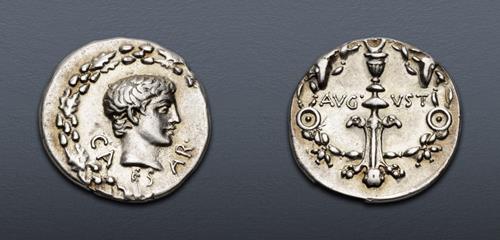|
Augustus. 27 BC-AD 14. AR Denarius (19mm, 3.84 g, 11h). Uncertain eastern mint. Struck circa 12 BC. Youthful, bare head right; all within oak wreath / Candelabrum, ornamented with rams’ heads; all within a floral wreath entwined with two bucrania and three pateras. RIC I 540; RSC 2 (Caius Caesar). Lightly toned with goldern iridescence, minor marks, slightly off center. Near EF. Rare. Struck in good metal.
From the Viggo Collection. Ex Rauch 112 (10 June 2021), lot 792.
R. Prideaux (Triton XI, lot 829) observes that this is a much discussed issue, primarily concerned with the identity of the person depicted on the obverse. The young head cannot be that of C. Caesar, as Sutherland, Robertson, Giard, and others have argued. It can only be Augustus, as the oak wreath was his personal signature.
Prideaux notes that two important questions need to be examined: (1) why is he portrayed with such a young face and (2) what is the meaning of this unusual reverse? On the first point, the engraver wasn’t working in a regular mint, with mint approved bust models, and wasn’t accustomed to drawing Augustus’ face. Therefore, he drew a generic profile adding the oak wreath to identify, beyond any doubt, the portrait. On the second point, it seems clear that, based on the symbolism, there is not only a religious, but a funereal theme. It is interesting to note that the sadness of the funeral-themed reverse is counterbalanced by a young portrait and the oak wreath, corona civica aurea, which was given to the citizen who saved another citizen’s life. Some have assigned this issue to the Ludi Saeculares of 17 BC, but while they were religious in nature, they were not funereal.
There is no reason for such a special type to have been issued in Rome or Lugdunum. Prideaux notes one striking event in the period after 17 BC that supports his theory. In 12 BC, Augustus’ chosen heir, Agrippa, died suddenly in Pannonia. We know that the news was taken hard in Rome, just months after Agrippa and his family had been officially made the heirs of the Empire (cf. C. Marius Tromentina’s issues in 13 BC). This event especially reverberated among the legions; they had lost a much admired and multi-victorious general in the middle of a difficult war.
Prideaux proposes that this candelabrum issue was struck in Pannonia to pay the now leaderless, and perhaps restless, Pannonian legions, without having to wait for a monetary delivery from the regular mint in very distant Lugdunum. A local celator, not versed in the portrait of Augustus, produced the dies. The themes reminded the soldiers of Augustus’ corona civica, while paying tribute to their beloved chief with a funeral overtone. The gold and silver issues (RIC 539-40) should be considered as a special Pannonian military mint issue of 12 BC. This helps explain many of the puzzling details of this issue.
The final winners of all CNG Feature Auction 121 lots will be determined during the live online sale that will be held on 6-8 October 2022. This lot is in Session Three, which will begin 7 October 2022 at 9 AM ET.
Winning bids are subject to a 22.5% buyer's fee for bids placed on this website and 25% for all others.
We recognize that our users may have various Internet Browsers and Operating Systems. We like our visitors to have the best possible experience when using our bidding platform. However, we do recognize that it is impossible to develop applications that work identically, efficiently and effectively on all web browsers. The CNG bidding platform supports the latest stable major version and stable previous version of Chrome and Firefox.
|
